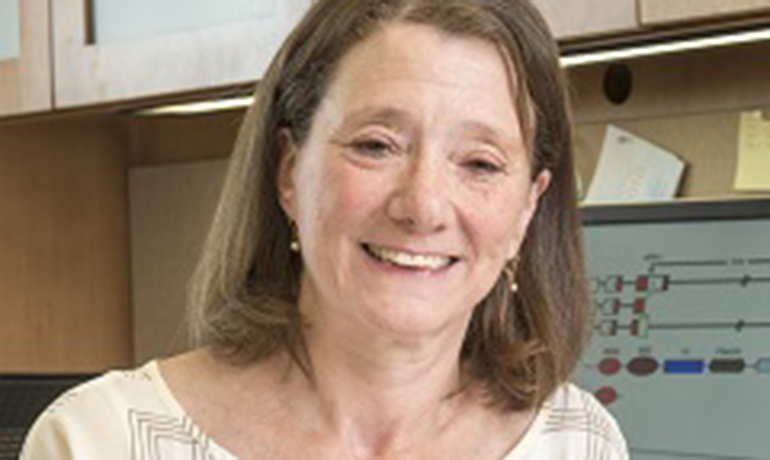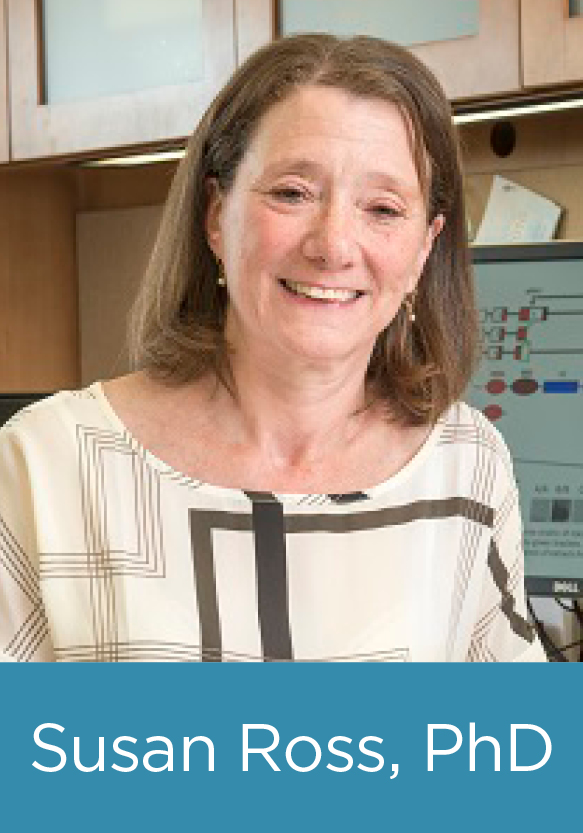
Susan Ross has never been afraid of mice. That’s a good thing, since she has spent her scientific career surrounded by the mammals.
 Ross, PhD, University of Illinois Cancer Center member and Sweeney Basic Science Professor and head of microbiology and immunology at the University of Illinois College of Medicine, studies the genetics of resistance and susceptibility to virus infections through the use of mouse models. One set of viruses her lab studies are retroviruses that cause cancer in mice, such as mouse mammary tumor virus (MMTV) and murine leukemia virus (MLV).
Ross, PhD, University of Illinois Cancer Center member and Sweeney Basic Science Professor and head of microbiology and immunology at the University of Illinois College of Medicine, studies the genetics of resistance and susceptibility to virus infections through the use of mouse models. One set of viruses her lab studies are retroviruses that cause cancer in mice, such as mouse mammary tumor virus (MMTV) and murine leukemia virus (MLV).
Mouse mammary tumor virus, a milk transmitted, infectious cancer-inducing agent discovered in the 1930s, is used as a model to study human breast cancer. A number of important oncogenes have been discovered by carrying out MMTV integration site analysis, some of which may play a role in human breast cancer, Ross said.
“MMTV was originally classified as a simple retrovirus,” said Ross, who is one of the foremost experts on the subject and one of the few researchers in the U.S. that still studies it. “Like other complex retroviruses, MMTV encodes a number of accessory proteins that both facilitate infection and affect host immune response. In animal models, the virus predominantly infects lymphocytes and mammary epithelial cells.”
High level infection of mammary epithelial cells ensures efficient passage of virus to the next generation, she said. It also results in mammary tumor induction, since the MMTV provirus integrates into the mammary epithelial cell genome during viral replication and activates cellular oncogene expression. Thus, mammary tumor induction is a by-product of the infection cycle.
Ross expanded her work several years ago to include MLV, which is “easier to work with in terms of studying susceptibility to infection,” she said. One of the host antiviral gene families she studies is APOBEC3, which mutate viral DNA during replication. However, several members in the family have been implicated in a variety of human cancers, she said.
“We’ve made mice that express human versions of these genes, particularly APOBEC3A and APOBEC3B and we’re studying whether there is a higher incidence of cancer in these models,” she said. The mice have also been sent to about a dozen laboratories throughout the world who are researching skin, lung and other cancers, Ross said.
DEAD-box helicase 41 (known as DDX41) is another gene discovered by Ross and her colleagues as important for controlling virus infection. DDX41 is also a tumor suppressor gene in acute myelogenous leukemia and myeloproliferative disorders (AML/MDS) in humans. Using mice with cell type-specific knockout of the Ddx41 gene, Ross’ lab found that DDX41 sensing in dendritic cells, but not macrophages, was critical for controlling in vivo MLV infection. They are currently investigating whether their knockout mice will serve as a model for human AML/MDS.
“Our work demonstrates that the innate immune response to retrovirus infection depends on multiple host nucleic acid sensors that recognize different reverse transcription intermediates,” she said. The new study has been published in the journal mBio.
Ross said her decision to become a scientist began with mice. A high school biology teacher taught she and her classmates about the experiments of Jan Baptist van Helmont that showed how a piece of soiled cloth mixed with wheat yielded mouse pups after a 21-day incubation period. When Ross inquired why there was no mother, since mice are mammals and nurse their young, the teacher replied that mice were rodents, not mammals. After conducting research at the library, Ross found that mice were indeed mammals, and she found her calling – that of a biologist.
As an undergraduate student at the University of Pennsylvania, Ross spent a summer working in Bernard Goldstein’s laboratory at New York University, using inbred mouse strains that included Himalayan mice to determine whether melanin conferred protection against ozone toxicity. Goldstein was a renowned toxicologist and his lab studied how air pollutants affected blood oxidation. Little did Ross know that that was the start of her career in mouse genetics.
“While my lab now uses a variety of approaches to identify the genes that confer resistance and susceptibility to infection, we always end up in the mouse,” Ross said. “The mouse has sometimes led us from our best-laid plans, but more often than not, it has led us to new, exciting avenues of exploration.”
